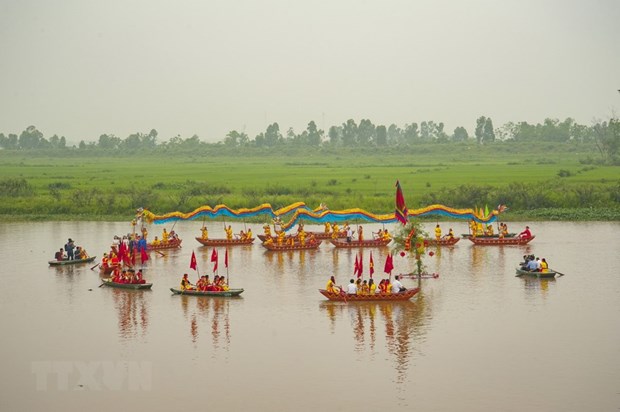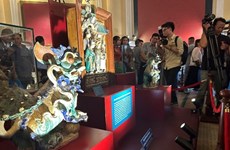Ninh Binh marks 1,050th anniversary of Vietnam’s first feudal state
 The water parade on the first day of Hoa Lu Festival (Photo: VNA)
The water parade on the first day of Hoa Lu Festival (Photo: VNA) Ninh Binh (VNA) – A series of activities to launch Hoa Lu Festival and mark the 1,050th anniversary of the establishment of Dai Co Viet, the first feudal state of Vietnam, began in the northern province of Ninh Binh on April 24.
The day saw thousands of visitors flocking to the local historical site of Hoa Lu ancient capital to take part in traditional rituals. The event started with water and palanquin parades and prayers. These activities aimed at honouring Dinh Bo Linh, who founded the Dinh Dynasty in 968 and chose Hoa Lu as his capital, and at praying for favourable weather, bumper harvests and a peaceful life.
Participants were also treated to sports, folk games and other cultural activities, such as tug-of-war games, a rice cooking contest, musical shows, water puppet performances, and an exhibition on Hoa Lu Festival.
Under the theme of “the 1,050-year journey of Dai Co Viet State in the flow of history”, the Hoa Lu Festival lasts through April 27.
In the late 10th century, Hoa Lu was the capital and the economic, political and cultural centre of Dai Co Viet founded by Dinh Bo Linh (968-979), and then the Early Le Dynasty (980-1009).
Dai Co Viet (Great Viet) was the first centralised feudal state in Vietnam which existed from 968 to 1010 AD. It was also the native land of three royal dynasties: the Dinh, the early Le and the Ly. Hoa Lu was the first capital of the country until King Ly Thai To moved the capital to Thang Long (now Hanoi) in 1010.
In the late 10th century, Vietnam was fragmented and was later reunited by Dinh Bo Linh, who founded the Dinh Dynasty in 968 and ascended to the throne under the name Dinh Tien Hoang.
The emperor chose Hoa Lu as his capital as it was protected by the Trang An mountains on three sides and by the Hoang Long River to the northwest. The strong walls linking the limestone mountains served as natural defences for Hoa Lu and also allowed the emperor’s forces to mount attacks against foes and to communicate with their subjects.
Over 42 years, the Dinh and the early Le dynasties erected palaces, temples and shrines at Hoa Lu. Due to the ravages of time, there are only about 30 vestiges related to the dynasties remaining, including the temples of King Dinh Tien Hoang and King Le Dai Hanh and Nhat Tru Pagoda.
The 300-ha Hoa Lu ancient capital is now a popular tourist destination in Ninh Binh, famous for beautiful landscapes with magnificent lime mountains and rivers.-VNA













